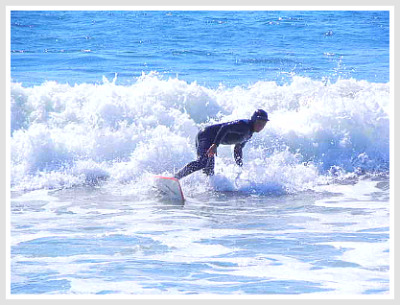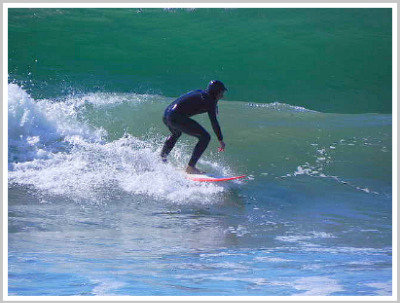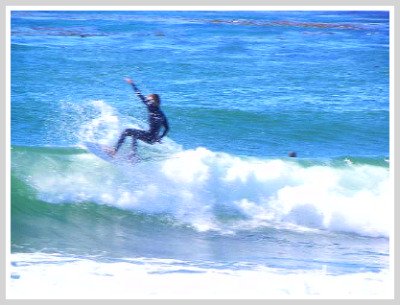Central Coast Surfing
I wanted to be a surfer and ride with the Little Old Lady from Pasadena but I settled for orange hair and a Ford Falcon.
My brother and his friend were the first to bleach their hair blond so I thought I would give it a shot. My hair was dark brown, almost black and all the bleach did was turn it orange. But, I still wanted to be a surfer.
If my family had lived near an ocean with waves I am sure I would have been on a board trying to hang ten.
Today I live within a stones throw of the beach and I would not get in that cold, sharkie water if someone payed me a million dollar.
When I first arrive in Cambria, California, I put my feet in the water and that ended any aspirations of swimming in the Pacific Ocean let alone surfing.
I remember telling my wife that I would go in the water in a diving bell with a rope tied to me so I wouldn't drift out to sea.
Of course, if I were that young kid who bleached his hair orange I would be out there with the rest of the surfers.
On this page we are going to provide.
1. Central Coast Surfing Links to surfing pictures
2. Central Coast Surfing Links to places to surf on the Central Coast.
3. Central Coast Surfing, Surfing ideas and opinions of surfing our coast.
5. Central Coast Surfing, Safety tips on surfing the Central Coast waters.
Central Coast Surfing - The picture below was taken in San Simeon, California

I know a lot
of older men who still surf and love the sport. Again, I say if I
had a diving bell I would go into the water but I guess I will never
surf.
I am going include a few important links. If you have never surfed the central coast waters I suggest you click on the links. If you are an great surfer and have surfed the area these links will help you determine when the surf is up.
1.
The Art of Surfing - A Training Manual. Central Coast Surfing.
This is really
interesting. If you have never surfed but admire the art then you
want to read this little manual.Central
Coast Surfing
3. What are the waves like. How about a surfline to give you all the need information on waves, etc.Surf Line
4. Safety information on surfing. Gee, I wonder if a real surfer is going to read this. OK, maybe not, but if you are a want to be surfer this is interesting reading. Like how to get away from a big ole White Shark. Well, you know what? I am going to give you the complete article by a fellow who says he knows what he is talking about.
Surfing - Surfing Safety Tips
Surfing - Surfing Safety Tips
By J
Edmond Souaid
It's very rare to break a leg surfing. But surfing carries its own inherent dangers. Forewarned is forearmed.
Drowning is the most obvious risk from surfing and there are a dozen ways to unintentionally raise the odds.
Not being prepared to surf is the first way. Surfing requires being fit, being able to swim well and then getting some training. Even the most advanced surfers fall of their boards.
When that happens you'll have to locate your board if it isn't attached to you by a safety leash to your ankle, then paddle back. If you lose your board or it washes ashore, you have to swim back. Either requires a lot of stamina, especially when there are strong currents, which is often the case. Get fit for surfing and ensure that you are a strong swimmer before going out into the water.
Not being alert is the second most common cause of problems while surfing.
For a sport that looks simple, there's a surprising number of things
to be aware of at all times. Winds near the shore can shift rapidly,
pushing you off your board. Current eddies and riptides can keep you
from swimming ashore easily.
Other surfers, especially inexperienced ones, can fail to look out for you. That means you have to look out for them. Crossing boards in the water is never a happy experience for anyone. Give priority to the surfer closest to the break. Even if someone else is being rude and not following the surfer's etiquette, don't lose your cool. That leads to accidents, or worse.
Underwater rocks, coral reefs and other unseen formations can damage you and your board. Even visible jetties can be a problem, since most of the formation is unseen. Jellyfish and other creatures can deliver a nasty sting. Watch out for all these by getting familiar with the common water movements that signal their presence.
Failure to exercise common sense and good judgment is another leading cause of injury for too many surfers. When you're beginning, it's easy to get carried away with the excitement and challenge. It's great to be enthusiastic, but don't take on waves bigger than your skills can handle. Don't be too eager to shoot a curl or surf among the pier pilings because it looks cool.
Always surf with at least one buddy. If you run into trouble, he or
she can help you out. One of you can make for shore and get help, if
needed. Sometimes two surfers can be put in trouble by the same event,
but the odds are more in your favor if you pair up.
It should be obvious by now that these are all common sense reminders. That's a signal that it doesn't require advanced surfing experience to recognize the dangers and avoid them. Just keep it together and you'll have that much more time for surfing. Injuries take you out of the game.
Another important safety tip, relates to skin protection. Wear UV protective swimsuits is the best type of skin protection, along with sunglasses, and applying sunscreens on exposed skin. So make sure you have your UV protection gear each time you go out surfing.
J Edmond have been working in the sun protection clothing industry for several years. The main aim is to raise awareness of the sun' UV radiation and it's effect on human skin. Click here for more info about sun protection swimwear and UV protective clothing.
Article Source: https://EzineArticles.com/?expert=J_Edmond_Souaid
https://EzineArticles.com/?Surfing---Surfing-Safety-Tips&id=1493829
Ok, surf is up and you need some camping equipment. Try camping world for great product and camping equipment.

CCTAdventures also provides a travel tips to help you plan your trip. For more information click on this link, Travel Tips.
Planning a visit to the central coast use Kayak to book your hotel or air flight to the central coast.
I am going to start giving you the what's up on surfing on a regular basis. I think I might even try to hang 10. Do you believe me? Well, anyways, I am going to stay on top of this central coast surfing things. Maybe even bleach my hair again. But, I don't think it can get any whiter.
Here is another page on surfing. I am starting to get into this surfing thing. Well, maybe I just like taking the pictures. Try this link to read more about surfing in California Surfing Moonstone Beach.


